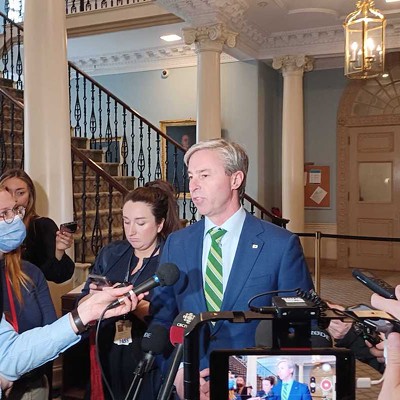"Tuition increases limited to 3%," a Herald headline proclaimed last week, over a story labelled EXCLUSIVE. It quoted "a senior government official," who cheerily said the province was imposing a three percent tuition cap "designed to protect Nova Scotia students, ensuring that their tuition will remain below the national average over the long term." The leak tried to put a positive spin on the government's decision to scrap a freeze on tuition and allow universities to hike fees by three percent each year over the next three while cutting university funding by four percent next year. It came one day before a student protest during which hundreds marched to Province House hoisting signs that read, "A University Education Shouldn't Bleed You Dry," a reference to the fact that student debt has more than doubled in the last 20 years.
Aside from well-timed newspaper leaks, the NDP government is trying to sell tuition hikes along with cuts to universities and public schools as the bitter medicine needed to help us "live within our means." That simple slogan suggests we have to cut because we can't afford current rates of social spending. This line has been spouted for decades by Canadian politicians of all stripes and trumpeted daily in the mainstream media. But, bear with me and I'll try to show why it's far from true, especially in the world's 15th richest country.
First, a surprising, but rarely acknowledged statistic: Canada's economic wealth has more than doubled over the last 40 years. In 1970, the country produced $18,691 worth of goods and services per person. Last year's figure was $38,043. (Both figures are adjusted for inflation.) Economists call it real gross domestic product per capita. It's a standard measure of a country's wealth. Surprisingly, even as national wealth more than doubled, we've reduced the proportion of it that goes to social spending. In 1981, we spent 21.5 percent of GDP on social programs. By 1995, we were down to 18.9 percent and by 2005, we spent 16.5 percent ranking a dismal 26th out of 30 industrial countries.
And no wonder. In 2008, Canada's tax revenues, at about 32 percent of our national wealth, were well below most other industrial countries. The media keep shouting that we're "taxed to the max." But that's not true, at least not in comparison with other advanced countries, ones with better social programs than ours.
As I see it, there's a quiet competition in Canada between public spending on social programs and private spending on consumer goods. Here's an astonishing figure to illustrate my point: Every year Nova Scotians shell out about $5.3 billion just to own and operate their cars. That exceeds the $5 billion the provincial government spends on health and education combined! If you add in community services (welfare, et cetera), government spending on social programs comes to nearly $6 billion or 20 percent of provincial GDP ---about one dollar in every five of our wealth, while private spending on the car comes to 18 percent of GDP (but that figure doesn't include public spending on highways, police and health care to patch up accident victims).
Yes, most car-related spending comes from our private incomes while social programs are mostly funded by tax dollars. The money for both comes from the same pocket. Right-wingers might argue that people can choose whether to buy a car, but are compelled to pay tax rates set by the government. True, but instead of hacking away at social programs, why not undertake massive improvements to more environmentally friendly public transit and shift the savings in car bills to health, education and welfare? We do have choices despite what the politicians and media keep preaching. We need to make a collective decision about how we spend our money. Lower taxes and more private spending on fancier cars, for example? Or higher taxes and more public spending on social programs including affordable universities?
notes:
1. Nova Scotia passenger vehicle registrations as of December 31, 2010 stood at 600,956, a figure which included 402,597 cars classified as sedans, station wagons and hatchbacks and 198,359 classed as vans, pickup trucks and SUVs.2. About 12 percent of those vehicles or 72,114 would be light commercial vehicles. So Nova Scotia families and individuals owned a total of 528,842 passenger cars at the end of 2010.
3. According to the annual cost of driving pamphlet issued by the Canadian Automobile Association based on calculations from Runzheimer International, the average cost of owning a car and driving 18,000 kilometres in 2010 was $10,057.50. (That's based on averaging the cost of operating a 2010, 4-cylinder compact vehicle ($8,524) and a 2010, 6-cylinder minivan ($11,591). I'm told that the 18,000 km figure should really be closer to 24,000 in N.S., but I decided to stick with it anyway to avoid any risk of inflating the cost figures which are also quite a bit lower than they should be because the costs of operating SUVs and pickup trucks are not included either.)
4. Calculation of what Nova Scotians per year spend owning and operating their cars: $10,057.50 X 528,842 = $5,318,828,415 or $5.3 billion --- more than health care and education spending combined.
5. Meantime total government spending on health care this year = $3,634,935,000; education and universities = $1,376,008,000; community services = $971,562,000. Grand total = $5,982,505,000

















